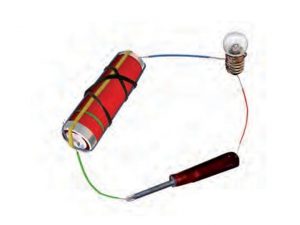Electricity and Circuits
Exercise:
1. Fill in the blanks :
(a) A device that is used to break an electric circuit is called a switch.
(b) An electric cell has two terminals.
2. Mark ‘True’ or ‘False’ for the following statements:
(a) Electric current can flow through metals.
True
(b) Instead of metal wires, a jute string can be used to make a circuit.
False
(c) Electric current can pass through a sheet of thermocol.
False
3. Explain why the bulb would not glow in the arrangement shown in Fig. 12.13.

The bulb would not glow in the arrangement shown in Fig. 12.13. because one end of the tester is made of plastic which is an insulator. It does not allow the electricity to pass through it.
4. Complete the drawing shown in Fig 12.14 to indicate where the free ends of the two wires should be joined to make the bulb glow.

Answer:

5. What is the purpose of using an electric switch? Name some electrical gadgets that have switches built into them.
A switch is a simple device that either breaks the circuit or completes it. So with the help of electric switch, we can ‘on’ or ‘off’ the electric devices as per our need. Electric iron, AC, TV are some gadgets that have switches built into them.
6. Would the bulb glow after completing the circuit shown in Fig. 12.14 if instead of a safety pin we use an eraser?
No, since the eraser is an insulator the bulb does not glow.
7. Would the bulb glow in the circuit shown in Fig. 12.15?

Yes, the bulb glow in the circuit as the circuit is closed.
8. Using the “conduction tester” on an object it was found that the bulb begins to glow. Is that object a conductor or an insulator? Explain.
If the object is a good conductor of electricity then the current flows through it and the bulb in the conduction tester glows. Therefore, the object is a conductor of electricity.
9. Why should an electrician use rubber gloves while repairing an electric switch at your home? Explain.
Our body is a good conductor of electricity. During the repairing of an electric device if our body comes in contact with the electric current then it would be fatal. Rubber is an insulator. Therefore, we can avoid electric shocks by wearing rubber gloves.
10. The handles of the tools like screwdrivers and pliers used by electricians for repair work usually have plastic or rubber covers on them. Can you explain why?
Plastic and rubber are insulators. They don’t allow the electric current to pass through them. Hence the handles of the tools like screwdrivers and pliers used by electricians for repair work usually have plastic or rubber covers on them to avoid electric shocks.
Additional questions:
1). Write whether True or False:
i). A power station provides us with electricity.
True.
ii). Electric cell is a source of electricity.
True
iii). A torch is used for providing light.
True.
iv). The metal cap is the negative terminal of an electric cell.
False
v). Thermocol is a conductor of electricity.
False
vi). The metal disc is the positive terminal of an electric cell.
False
vii). All electric cells have two terminals.
True
viii). In an electric circuit, the direction of current is taken to be from the positive to the negative terminal of the electric cell.
True.
ix). Rubber is a good conductor of electricity.
False.
x). Plastic is an insulator.
True.
xi). Air is an insulator.
True
2). Fill in the blanks.
i). An electric cell produces electricity from the chemicals stored inside it.
ii). All electric cells have two terminals.
iii). The bulb glows only when current flows through the circuit.
iv). An electric bulb has a filament that is connected to its terminals.
v). The human body is a conductor of electricity.
3). Answer the following.
i). What is an open circuit?
In an electric circuit if the contact at any point is broken then it is called an open circuit.
ii). Define electric switch.
A switch is a simple device that either breaks the circuit or completes it.
iii). Name the devices that use electric cells.
Electric cell are also used in alarm clocks, wristwatches, transistor radios, cameras and many other devices.
v). What is the flow of direction of electric current?
The electric current flows in a direction from the positive terminal to the negative terminal.
vi). What are conductors of electricity?
Materials that allow an electric current to pass through them are conductors of electricity.
vii). Write two advantages of dry cell.
i). It converts chemical energy to electric energy
ii). It is easy to carry.
4). Name the following.
1). Thin wire in the electric bulb.
Filament.
2). Two terminals of the electric cell.
i). positive terminal ii). Negative terminal
3). Conductors of electricity
i). Iron ii). Copper
4). Insulators
i). Plastic ii). Rubber
5). Classify the following as conductors and insulators.
Paper, wood, eraser, matchstick, copper, pencil lead, iron
| Conductors | Insulators |
| Copper
Iron Pencil lead
|
Paper
Wood Eraser Matchstick |
Distinguish between
i). conductors and insulators.
| conductors | insulators |
| i). Materials that allow an electric current to pass through them are conductors of electricity
|
i). Insulators do not allow an electric current to pass through them.
|
| ii). Copper and aluminum are conductors of electricity. | ii). Rubber and plastic are insulators. |
Click here for the solutions of
11). Light, Shadows and Reflection
10). Motion and the Measurement of Distances
9). The Living Organisms – Characteristics and Habitats
4). Sorting Materials into Groups
1). Food: Where Does It Come From?
![]()

